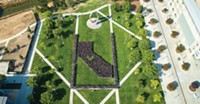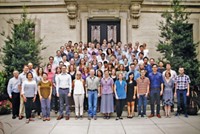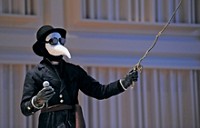Advertisement
Grab your lab coat. Let's get started
Welcome!
Welcome!
Create an account below to get 6 C&EN articles per month, receive newsletters and more - all free.
It seems this is your first time logging in online. Please enter the following information to continue.
As an ACS member you automatically get access to this site. All we need is few more details to create your reading experience.
Not you? Sign in with a different account.
Not you? Sign in with a different account.
ERROR 1
ERROR 1
ERROR 2
ERROR 2
ERROR 2
ERROR 2
ERROR 2
Password and Confirm password must match.
If you have an ACS member number, please enter it here so we can link this account to your membership. (optional)
ERROR 2
ACS values your privacy. By submitting your information, you are gaining access to C&EN and subscribing to our weekly newsletter. We use the information you provide to make your reading experience better, and we will never sell your data to third party members.
Careers
Mel D. Schiavelli
Chemist turned university president talks about the challenges of starting a university
by Celia Henry Arnaud
January 2, 2012
| A version of this story appeared in
Volume 90, Issue 1

One Sunday in December 2001, Mel D. Schiavelli, a retired chemistry professor and university provost at the College of William & Mary and the University of Delaware, was driving on the Pennsylvania Turnpike. When he stopped for coffee and a newspaper, he read about a new science-and-technology-focused university being started in Harrisburg. A self-proclaimed “bad retiree,” Schiavelli called the person in charge the next day and volunteered to help. By Tuesday, he was involved with the planning of what would be Harrisburg University of Science & Technology. He became the first president in April 2002.
Schiavelli and his fellow planners had a blank piece of paper and the charge to build a university. They decided not to do things like a typical university. The most noticeable difference is the lack of tenure for the faculty. “We knew we couldn’t afford tenure,” Schiavelli says. “It was a business decision.” The university’s full-time faculty members instead have 12-month contracts.
“My friends at William & Mary told me I had unilaterally disarmed by taking tenure away, and I wouldn’t get anybody,” Schiavelli says. They received more than 400 applications for 12 full-time faculty positions. “We had a dozen people who left tenure-eligible jobs” for the opportunity to build the school from scratch. Today, the faculty consists of 16 full-time professors and 29 part-time “corporate faculty” who work in industry, teach classes, and serve as internship mentors.
Those faculty members were attracted by the university’s multidisciplinary programs, Schiavelli says. Instead of traditional departments and majors, the university ties its programs to local industry. For example, nearby engineering and logistics firms helped develop the university’s geospatial technology program. The university teamed up with the Pennsylvania Department of Agriculture and Hershey Co. to design a food safety program.
Schiavelli encourages his faculty to think beyond the conventional major. He challenged the people designing the university’s computer science program to create a program that would educate a “whole individual.” He asked them what an undergraduate who specialized in computer science should know, including topics like writing and history.
“You have to build that person,” he says. “It was a long time before the faculty got that notion of what it means to be an educated individual in science and technology.”
The university provides much of that education through its extensive general education program. Every student takes three foundational courses in mathematics and in English and communication, followed by 30 credits of interdisciplinary courses with titles such as “The Creative Mind,” “The Scientific Mind,” “The Civic Mind,” and “The Organizational Mind.” The courses provide the same sort of broad-based foundation, including critical thinking and oral and written communication, as the general programs at liberal arts colleges.
In addition to teaching a few traditional courses, such as introductory chemistry and organic chemistry, the university offers a one-credit seminar course every semester that covers topics including résumé writing and public speaking. “The transformation that occurs along the way, making students confident individuals, is as important as the technical skills they learn,” Schiavelli says.
On top of their course work, each student is required to undertake two projects and an internship at partner organizations. For example, students in the biotechnology program can work on projects at Pennsylvania State University’s nanotechnology center. Such programs can look more like undergraduate research than a conventional summer job.
The school now has more than 1,000 students, about 60% full-time undergraduates, 20% part-time and transfer students, and 20% graduate students. The university draws the majority of its student body from a 250-mile radius around Harrisburg, and it has recruited heavily in high schools in Philadelphia, Pittsburgh, Baltimore, and Washington, D.C.
“We mirror the population of those urban centers,” Schiavelli says. The recruitment strategy has led to a couple of “happy happenstances”: The student body is 53% women and 44% minorities.
“Last summer, during our regular 15-week summer term, we had 12 African American women taking organic chemistry,” Schiavelli says. “In 20 years of teaching organic chemistry at William & Mary, I don’t think I taught a total of 12 African American women.”
The university tries to make sure that all students are committed to studying science and technology. “Motivation to study science is hard to assess,” he notes. Admissions officers gauge that interest through interviews.
Despite being private, the university tries to keep itself affordable. The annual tuition is $22,500, and industry supports many of the students through scholarships. The average student’s loan burden is about 20% less than the national average, and 90% of the students in the first two graduating classes were employed when they graduated.
Schiavelli is focused on scaling up the program now. One challenge as the student body grows is finding the required internships for students. Another challenge to growth is finding ways for current faculty to connect with increasing numbers of students. One way Schiavelli anticipates doing this is through online “personalized learning modules” that students can use outside of class.
“We’re trying to develop exercises that complement in-class work and are as exciting as gaming and simulations,” he says. “That takes a big investment.”





Join the conversation
Contact the reporter
Submit a Letter to the Editor for publication
Engage with us on Twitter